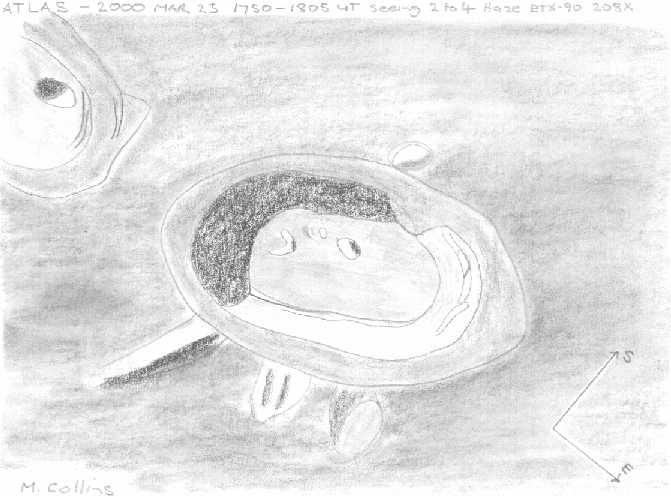
Libration Areas
By F. Badalotti, M. Collins, R. Lena, Pg. Salimbeni
We can observe up to 9 % of the Moon's farside through the phenomena of librations. These are apparent oscillations of the Moon's disk due to the imperfect synchronization of the lunar rotation and revolution motions.
With the librations we can to see regions of the Moon that are located beyond the edge of the boundary with the invisible hemisphere, with a latitude and longitude alternation. With the latitude libration, the northern and southern polar regions will be visible. With the longitude libration, a point located on the Moon surface during a lunation will shift alternatly by 8° to the east or west. It will then be possible to observe the regions located farther beyond the eastern and western edge. This second libration phenomena has its origin in the elliptical lunar orbit. On
consideration of the regularity of the Moon's rotation on her axis, our satellite has a more rapid orbital motion when at perigee than at apogee, the Moon has a variable speed though its revolution, yet it has an identical duration to the rotation.
Finally, there is the parallatic libration due to the point that the observer is located on the Earth's
surface. A consequence of this libration's effect is to trace a spiral curve inserted in a 10° circle, for every point located on the Moon's surface. It's called the apparent libration.

F. Badalotti (Schmidt Cassegrain 25 cm f/10 and videocam) 26 may 1996.E-NE, mare Humboldtianum and Hercules , Atlas.

F. Badalotti (Schmidt Cassegrain 25 cm f/10) 26 may 1996.
E-NE Endymion e De La Rue.

F. Badalotti (Schmidt Cassegrain 25 cm f/10) 31 may 1996. Otto Struve and Riccioli.
To undertake a systematic observation plan of the regions located immediately on the lunar farside edge, we need to consider some elements that will determine our researches.
In an era in which our satellite has been widely flown over by many lunar missions searching both hemispheres, and also the libration regions, the reasons that we bring to undertake
these observations are in our desire to study the Moon, especially concerning the different observability of lunar surface structures.
Throughout a lunation the farside regions are observed, it is not a casual effect, but is determined by the lunar motions, which alternatly show the east-west and north-south lunar edges. Therefore with the knowledge of this necessary information it will be possible design your own observation plan.

F. Badalotti (Schmidt Cassegrain 25 cm f/10) 31 may 1996. W-NW with Cenopides, Xenophanes, Lavoisier.

F. Badalotti (Schmidt Cassegrain 25 cm f/10) 31 may 1996. NW and Pythagoras.

F. Badalotti (Schmidt Cassegrain 25 cm f/10) 31 may 1996. W Otto Struve, Cardanus and Galilei.

Pg Salimbeni- drawings and report about Atlas (SCT 20 cms f/10 200x)

M. Collins -drawings of Atlas with an ETX 90.
M. Collins drawing of Schiller crater (ETX 90).
The structures that we usually observe on the lunar surface that exhibit a prevalently circular shape, except the craters by superimposition show this result. But it in the region located in the
center of the lunar disk that we will see the craters exhibiting a perspective crush. Analogously, an identical perspective crush is also seen for the lunar plains. Besides the perspective effects, we must to consider the negative effect of atmospheric turbulence, that, both together,
contribute to make it difficult and precarious to undertake the visual analysis, photographic, CCD and video observations of the lunar farside edge.

F. Badalotti (Schmidt Cassegrain 25 cm f/10) 31 may 1996. Riccioli and adiacent region.
The GLR group is interested in the development of these researches . Several our works concerning the libration areas will be reported in the future.
Thank you at all the GLR observers!
Rome 8 june 2000.